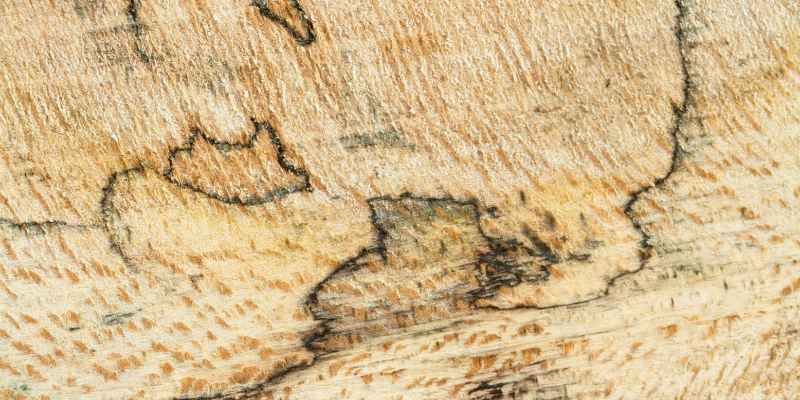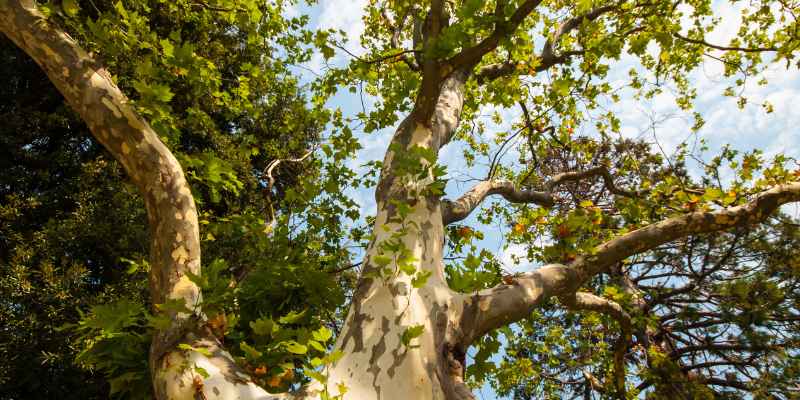Yes, Sycamore is classified as a hardwood. This type of wood is known for its strength and durability, making it a popular choice for furniture, flooring, and cabinetry.
Sycamore wood is easily recognized by its light color and distinctive grain pattern, which adds an attractive aesthetic to any space. Additionally, this hardwood is relatively easy to work with, making it a go-to material for carpenters and craftsmen. Whether you’re looking for a natural and timeless look or a practical and long-lasting solution, Sycamore hardwood is an excellent option to consider.
What Is Sycamore?
Sycamore is a hardwood with a distinctive grain pattern, making it a popular choice for furniture and flooring. Known for its durability and strength, it adds a touch of elegance to any space.
Characteristics Of Sycamore
Platanus occidentalis, is native to North America and belongs to the Platanaceae family. It is a deciduous tree with a striking appearance, featuring a smooth and pale gray bark that peels off in patches. The wood itself is light in color, ranging from creamy white to a pale straw color. What sets sycamore apart from other hardwoods is its uniquely interlocked grain pattern, which can create beautiful and eye-catching effects when used in woodworking projects.
The heartwood of sycamore is moderately resistant to decay, making it a durable option for furniture and outdoor applications. It is also relatively easy to work with, as it is neither too hard nor too soft. This means that it can be smoothly cut, shaped, and joined to create stunning pieces.
While sycamore is typically used as a hardwood, it is worth noting that the softer sapwood, which is more susceptible to decay, can also be used in certain applications.
Common Uses Of Sycamore
Sycamore wood is highly regarded by woodworkers and craftsmen due to its appealing aesthetics and versatility. Here are some common uses of sycamore:
- Furniture: Sycamore is often used for crafting cabinets, tables, chairs, and other furniture pieces due to its attractive grain patterns and durability.
- Flooring: The light color and unique grain pattern of sycamore make it a popular choice for flooring, adding warmth and character to any space.
- Millwork: Sycamore can be used for decorative millwork applications, such as paneling, moldings, and trim, thanks to its distinct appearance.
- Veneer: Sycamore veneer is highly sought after for its beautiful grain patterns. It is commonly used for decorative purposes on furniture, doors, and panels.
- Musical Instruments: Sycamore is a preferred wood for crafting musical instruments, including guitars, mandolins, and pianos. Its tonal qualities and visual appeal make it a popular choice among luthiers.
In addition to these applications, sycamore is also used in turnery, carving, and other artistic projects where its unique appearance can be showcased.
So, whether you’re a woodworker, craftsman, or simply passionate about woodworking projects, sycamore is definitely a hardwood worth considering. Its beauty, durability, and versatility make it a fantastic choice for a wide range of applications.

Is Sycamore A Hardwood?
When it comes to selecting the right wood for a particular project, understanding the characteristics of different wood types is essential. If you are wondering whether sycamore is a hardwood or not, you have come to the right place. In this section, we will explore the classification of sycamore and its composition, and compare it to other hardwoods.
Defining Hardwood And Softwood
Before delving deeper into the topic, it is important to define what hardwood and softwood mean in the world of woodworking. While the terms “hardwood” and “softwood” may suggest that the former is harder and the latter is softer, their classification actually pertains to the type of trees they come from.
Hardwood is derived from deciduous trees, which typically lose their leaves during colder months. These trees have a slow growth rate, resulting in denser and harder wood. On the other hand, softwood is derived from evergreen trees that keep their leaves year-round. Softwood trees grow at a faster rate, resulting in less dense and softer wood.
Composition Of Sycamore
Sycamore, scientifically known as Platanus occidentalis, falls under the hardwood category. This hardwood variety is widely recognized for its beautiful fine-to-medium grain, which can add an elegant touch to any project.
The wood obtained from sycamore trees is characterized by its moderate hardness, making it suitable for a wide range of applications. It is not as hard as some other hardwoods like oak or maple, but it offers good workability and durability.
Comparison To Other Hardwoods
When comparing sycamore to other hardwoods, it is essential to consider the specific characteristics that differentiate them. While sycamore may not be as hard as oak or maple, its unique grain pattern and figure make it an attractive choice for furniture, cabinetry, and decorative items.
In addition to its aesthetic appeal, sycamore also offers excellent stability, resistance to warping, and good machining properties. These qualities, coupled with its affordability, make it a popular choice among woodworkers.
| Wood Type | Hardness | Grain Pattern | Best Uses |
|---|---|---|---|
| Sycamore | Moderate | Fine-to-medium | Furniture, cabinetry, decorative items |
| Oak | Hard | Varies (ring, straight, or cathedral) | Flooring, furniture, cabinetry |
| Maple | Hard | Uniform and subtle grain | Flooring, cabinetry, musical instruments |
In conclusion, sycamore can be classified as a hardwood. While it may not be the hardest wood available, it offers a unique grain pattern and excellent workability. Whether you are a professional woodworker or a DIY enthusiast, considering sycamore for your next project can add a touch of elegance and versatility.
Resilience And Durability Of Sycamore
Sycamore, known for its resilience and durability, is a hardwood that offers long-lasting strength and stability in various applications. Its robust nature makes it a popular choice for furniture, flooring, and cabinetry. It is an excellent option for those seeking a strong and reliable wood material.
Natural Properties Of Sycamore
Sycamore is a hardwood that boasts natural properties which contribute to its resilience and durability. Its strong composition and unique characteristics make it an excellent choice for various applications.
One of the remarkable qualities of sycamore is its natural resistance to pests and decay. This hardwood possesses compounds that naturally repel insects and prevent fungal growth, such as rot. Unlike other types of wood that require frequent treatments and maintenance against pests and decay, sycamore remains strong and intact without the need for extensive protection.
Moreover, sycamore exhibits exceptional strength and resistance to wear and tear. Its robust structure ensures longevity and durability, making it suitable for high-traffic areas and heavy-duty applications. Whether it’s used for furniture, flooring, or cabinetry, sycamore can withstand the daily demands of everyday use, making it an ideal choice for both residential and commercial purposes.
To illustrate the strength and resistance of sycamore, a comparison table is provided below:
| Wood Type | Strength | Resistance to Wear and Tear |
|---|---|---|
| Sycamore | High | Excellent |
| Other Hardwood | Varies | Dependent on Species |
In conclusion, the resilience and durability of sycamore as a hardwood are truly impressive. Its natural properties, including resistance to pests and decay, along with its strength and resistance to wear and tear, make it a top choice for a wide range of applications. Whether you’re looking for furniture that will withstand the test of time or flooring that can handle heavy foot traffic, sycamore is a reliable and long-lasting option.
Sycamore In Furniture Making
Sycamore is a popular hardwood choice in furniture making, known for its durability, versatility, and beautiful grain patterns. It is a hardwood variety that has been used for centuries to create exquisite furniture pieces. In this section, we will explore the benefits of using sycamore in furniture making and look at some examples of sycamore furniture.
Benefits Of Using Sycamore In Furniture
Sycamore offers several advantages when used in furniture making:
- Durability: Sycamore is a sturdy hardwood that can withstand the test of time, making it ideal for creating enduring furniture pieces.
- Versatility: Sycamore can be easily crafted into various furniture styles, from contemporary to traditional, due to its adaptability.
- Distinctive grain patterns: Sycamore’s grain patterns are visually appealing, featuring a combination of straight and wavy lines that add character to furniture.
- Easy to work with: Sycamore is relatively easy for furniture makers to work with, as it is less prone to splintering or cracking during the construction process.
Examples Of Sycamore Furniture Pieces
Sycamore is used in a wide range of furniture pieces, offering both beauty and functionality. Here are some examples:
| Furniture Piece | Description |
|---|---|
| Sycamore Dining Table | A sycamore dining table is the centerpiece of any dining room, providing a beautiful surface for gatherings and meals. |
| Sycamore Bed Frame | A sycamore bed frame adds elegance and warmth to any bedroom, creating a cozy and inviting atmosphere. |
| Sycamore Coffee Table | A sycamore coffee table is a stylish and functional addition to a living room, perfect for displaying decor and providing a surface for drinks and snacks. |
| Sycamore Wardrobe | A sycamore wardrobe offers ample storage space while bringing a touch of nature into the bedroom, with its rich color and unique grain patterns. |
These are just a few examples of the many exquisite furniture pieces that can be created using sycamore. Whether it’s a dining table, bed frame, coffee table, or wardrobe, sycamore adds a touch of elegance and timeless beauty to any room.
Caring For Sycamore
Sycamore is classified as a hardwood, known for its durability and strength. Its characteristics make it a popular choice for furniture and flooring due to its resistance to wear and tear.
Maintenance Tips For Sycamore Furniture
Caring for your Sycamore furniture is crucial to ensure its longevity and keep it looking beautiful for years to come. Follow these maintenance tips to maintain the natural beauty and strength of your Sycamore pieces.
- Clean your Sycamore furniture regularly by dusting or using a soft cloth to remove any surface dirt. Avoid using abrasive cleaners or harsh chemicals that can damage the wood.
- Wipe up any spills immediately to prevent stains from setting into the wood.
- Avoid placing your Sycamore furniture in direct sunlight or near heat sources, as this can cause the wood to fade or warp over time.
- Protect your Sycamore furniture from excessive humidity or dryness, as these conditions can cause the wood to expand or contract, leading to cracks and other damage.
- Use coasters, placemats, or trivets to protect the surface of your Sycamore furniture from hot dishes, glasses, or other items that can leave marks or cause heat damage.
- Inspect your Sycamore furniture periodically for any signs of wear or damage, such as loose joints or scratches. Address these issues promptly to prevent further damage.
Protective Finishes For Sycamore
Applying a protective finish to your Sycamore furniture can help enhance its durability and protect it from everyday wear and tear. Here are some commonly used protective finishes for Sycamore:
| Finish Type | Description |
|---|---|
| Lacquer | A clear or colored finish that provides a hard and durable coating. It enhances the natural beauty of Sycamore while protecting it from moisture and scratches. |
| Oil | An oil finish penetrates the wood and provides a natural look while protecting it from moisture. It requires periodic reapplication to maintain its effectiveness. |
| Wax | Wax finishes provide a soft sheen and a protective layer against moisture and minor scratches. Regular waxing helps maintain the beauty and luster of Sycamore furniture. |
Before applying any protective finish, ensure that the surface of your Sycamore furniture is clean and dry. Follow the manufacturer’s instructions for the specific finish you choose, and consider testing it on a small, inconspicuous area before applying it to the entire piece.
Conclusion
Sycamore, with its stunning appearance and versatile nature, is indeed considered a hardwood. Its strong and durable characteristics make it a popular choice for various woodworking projects. Whether you’re a DIY enthusiast or a professional craftsman, Sycamore can provide you with beautiful and long-lasting results.
Its distinctive grain patterns and natural color variations add a touch of elegance to any project. Embrace the beauty and strength of Sycamore in your next woodworking endeavor.


